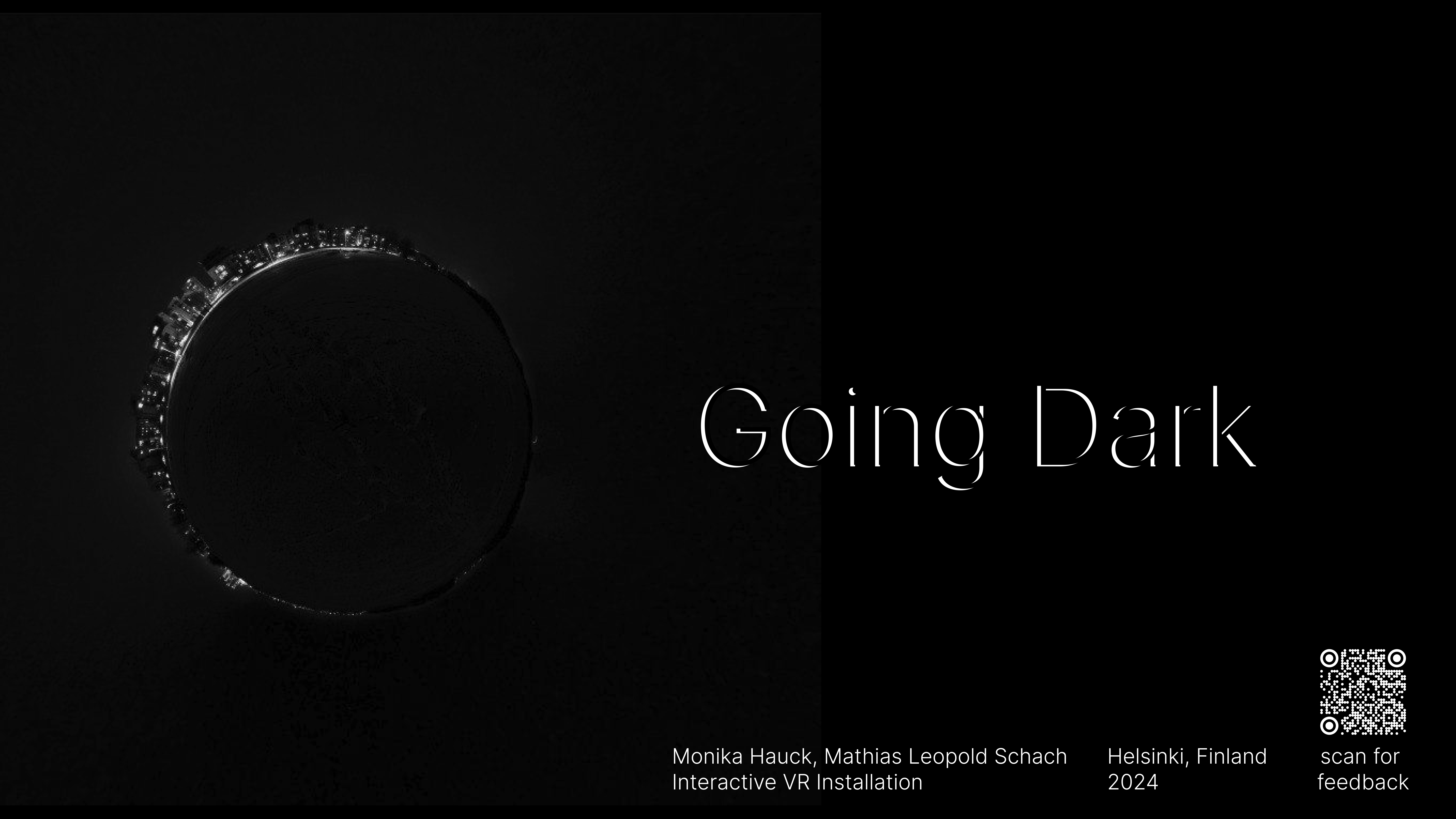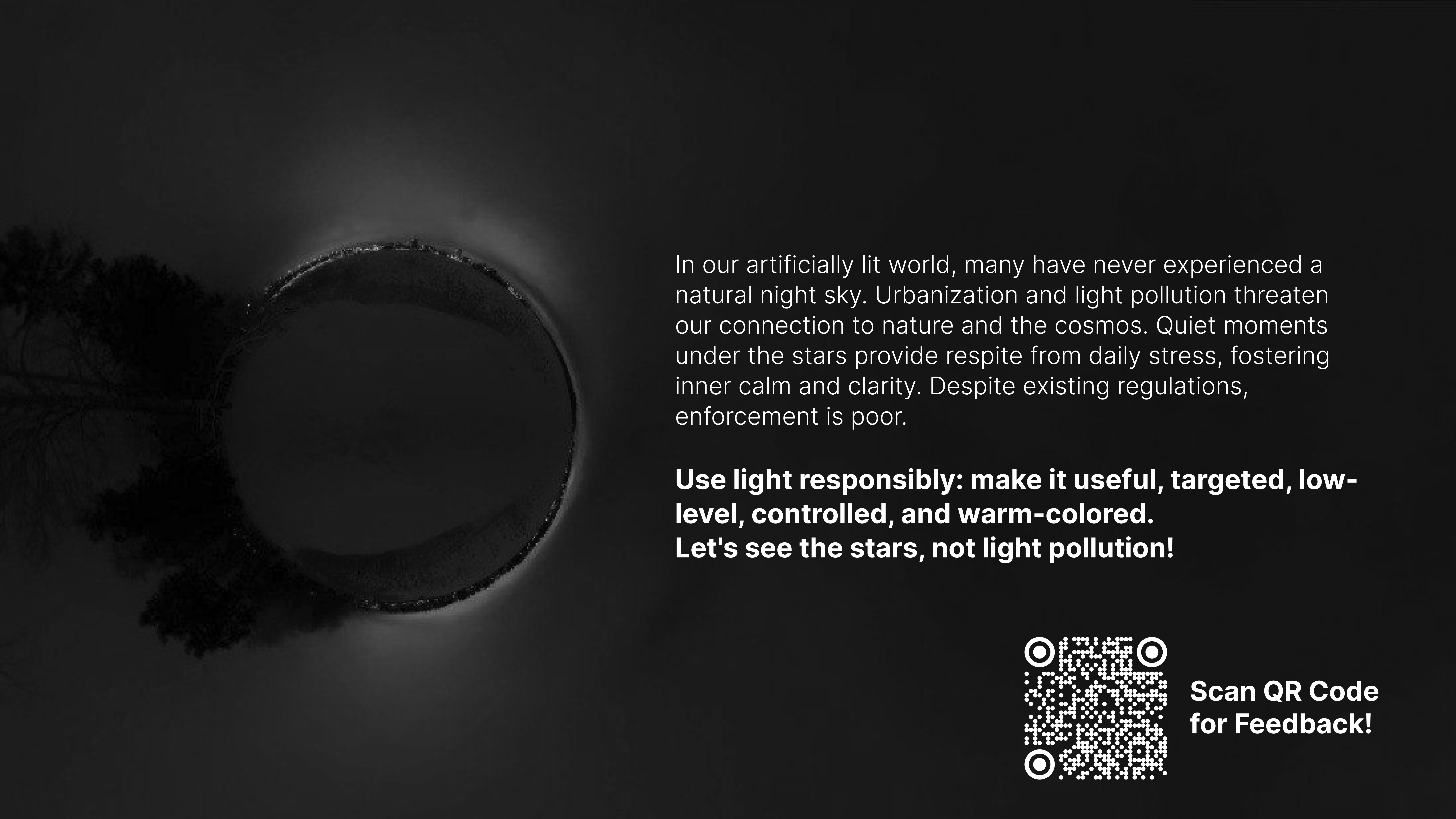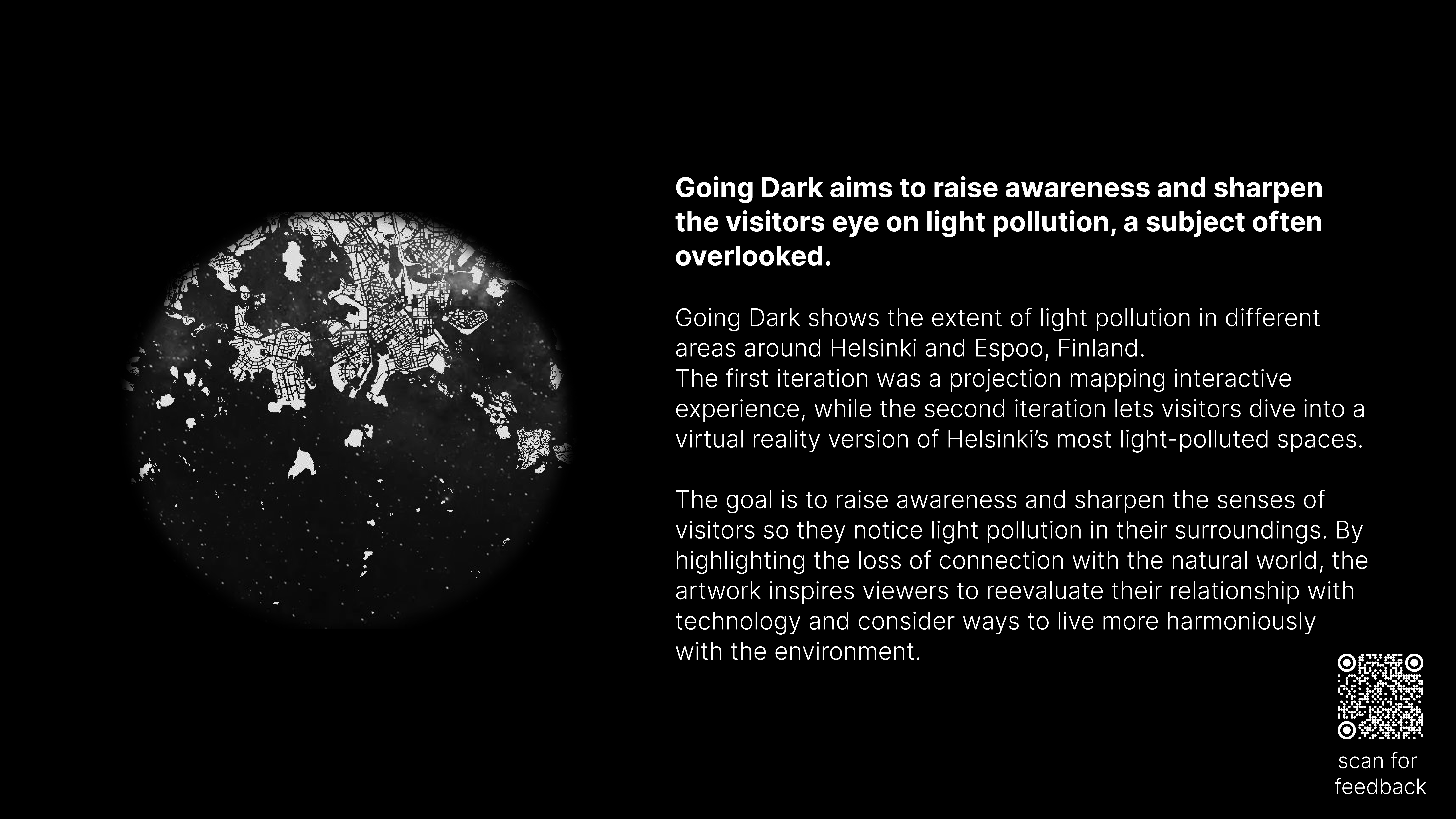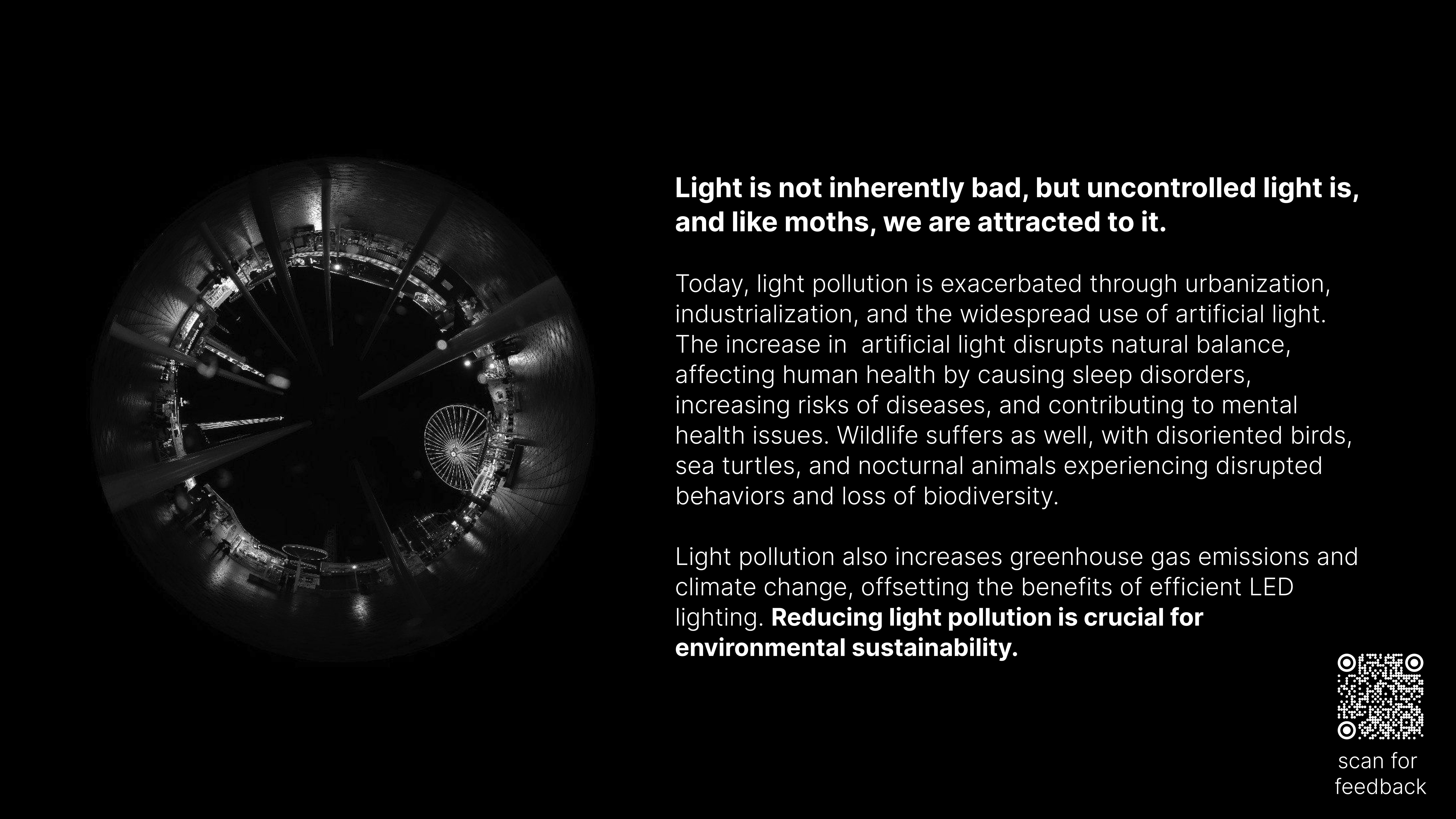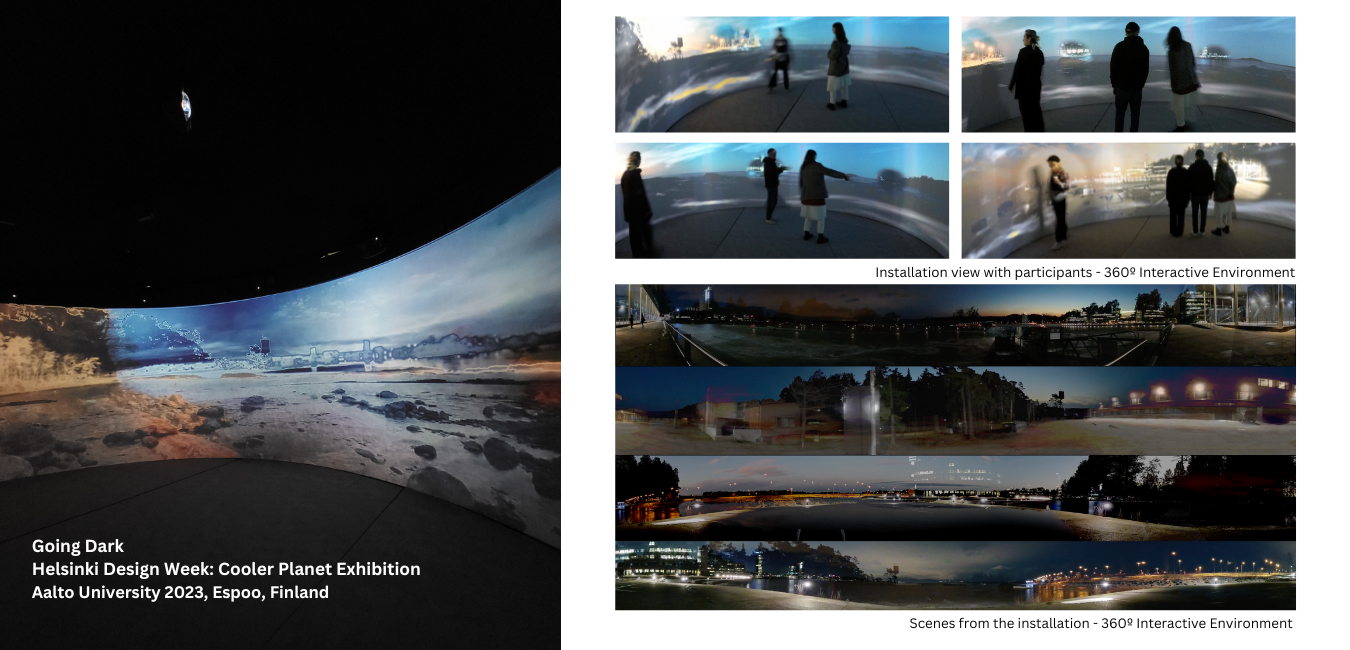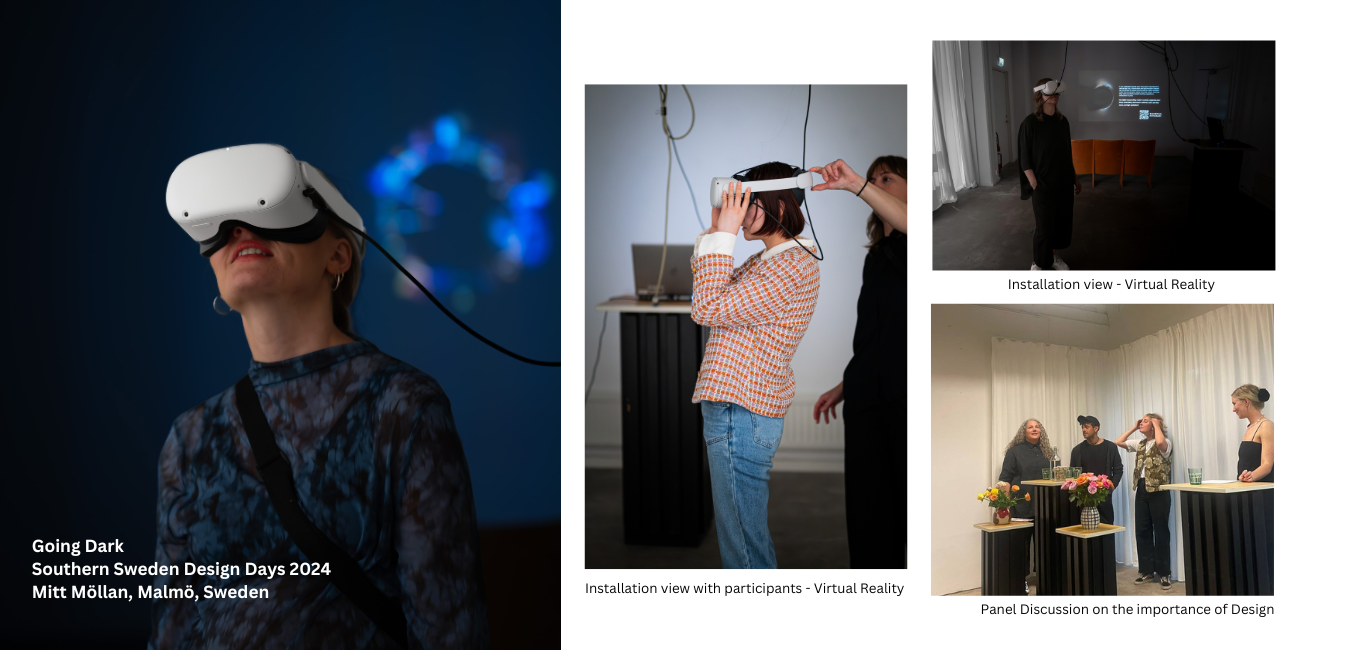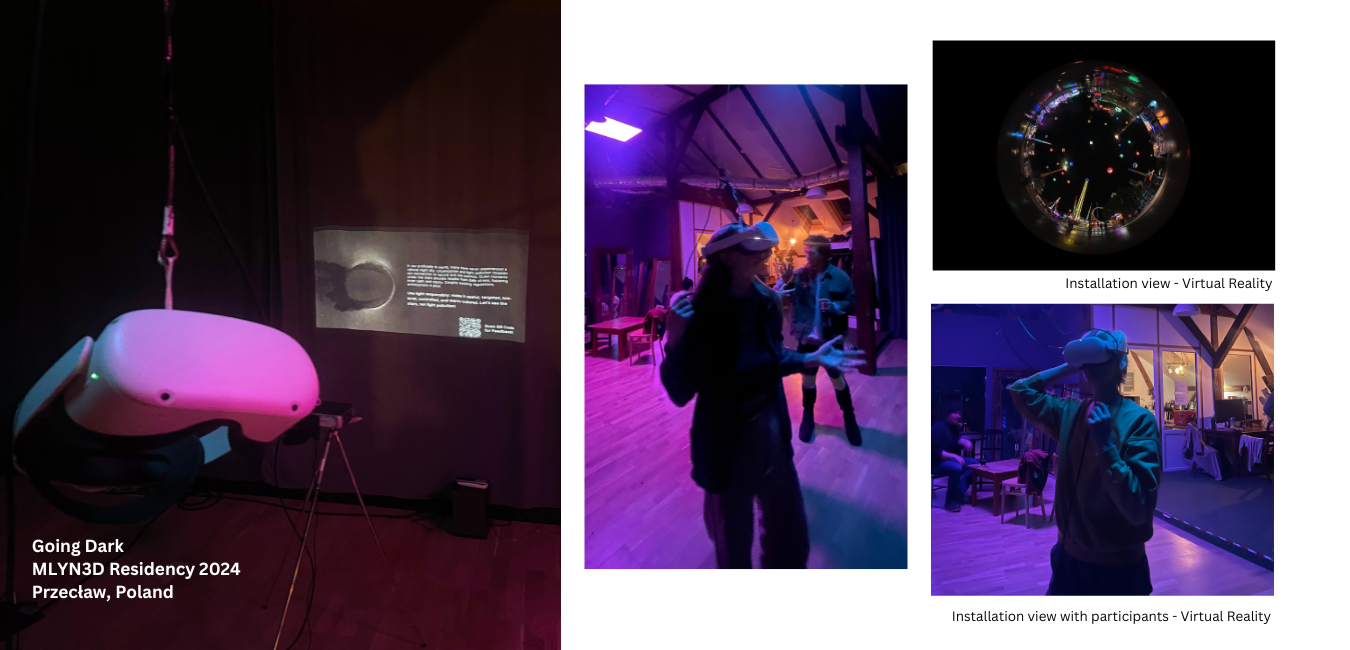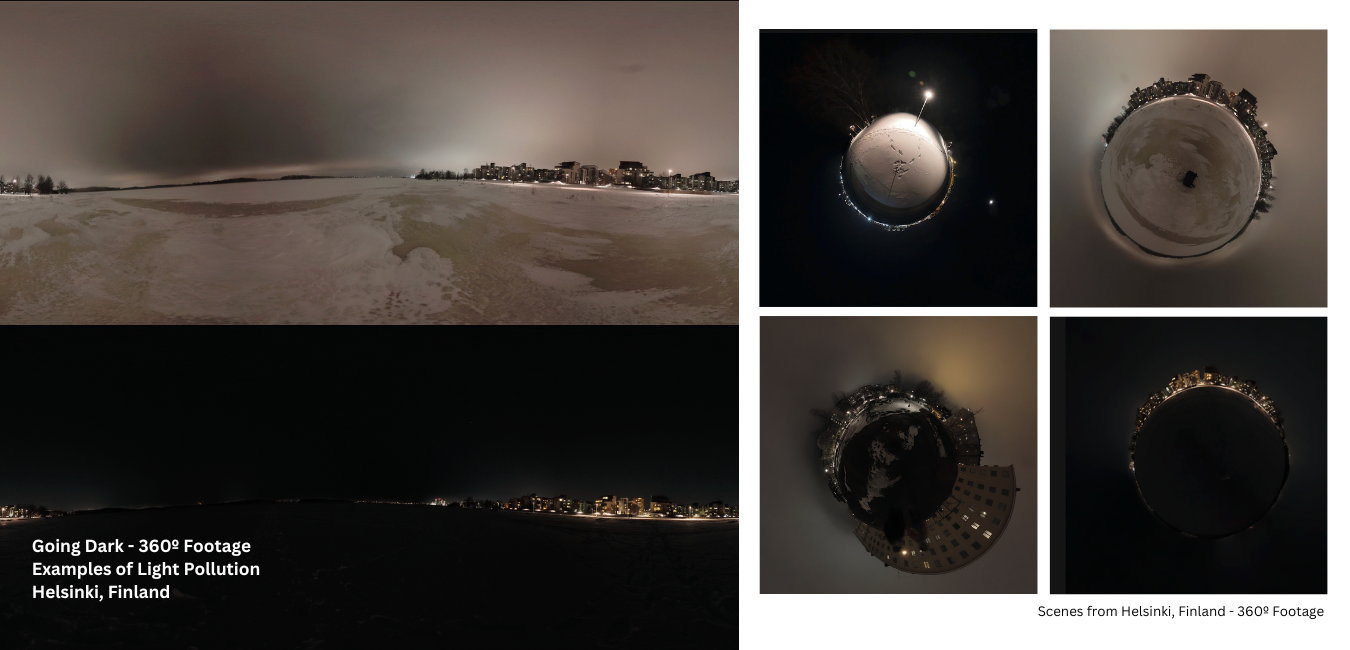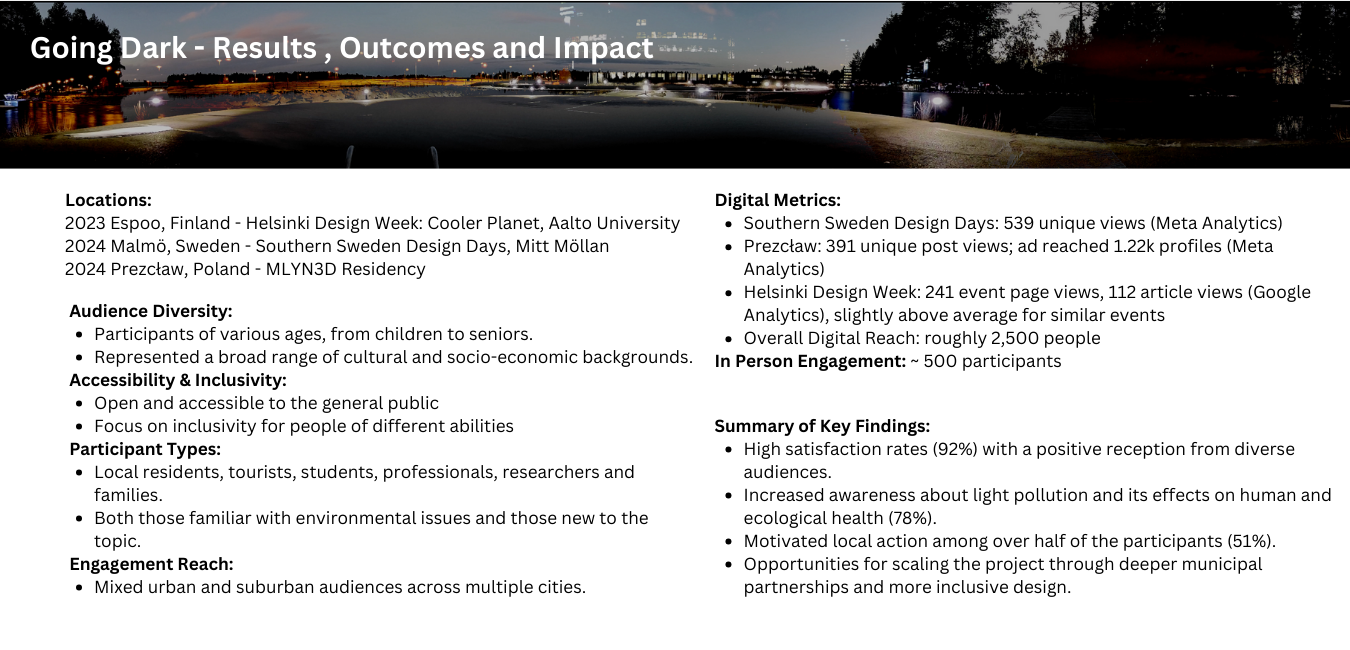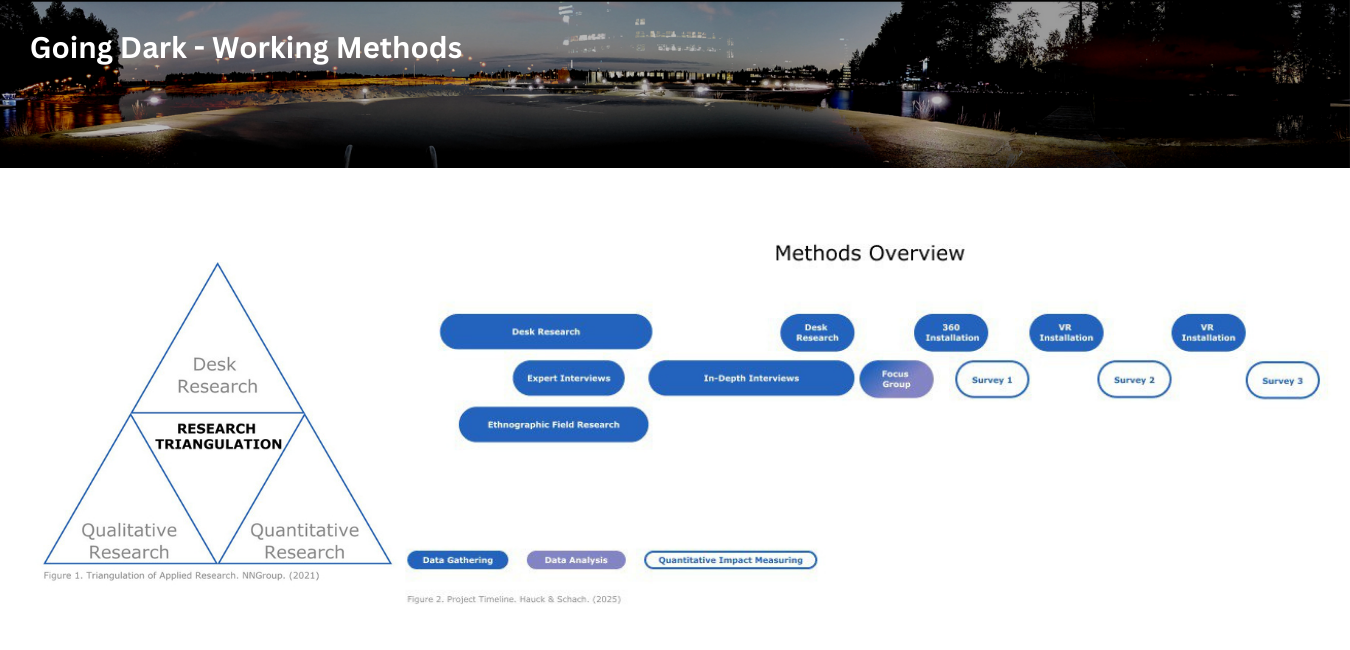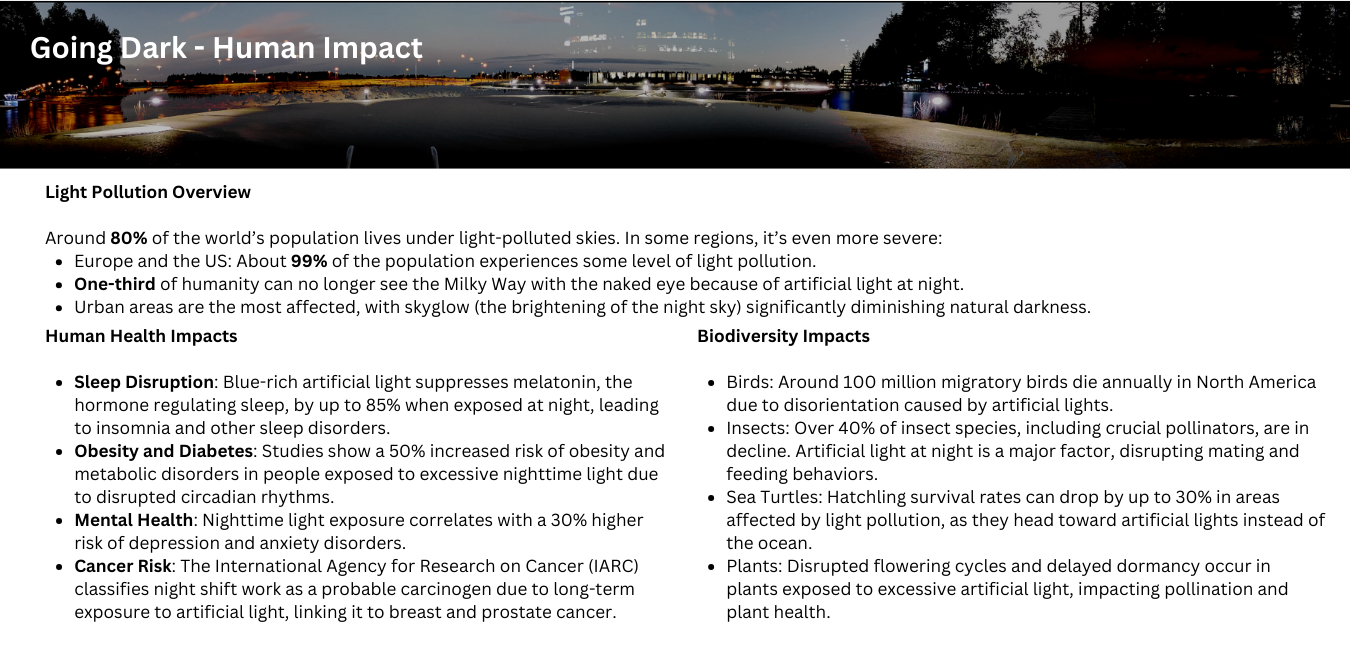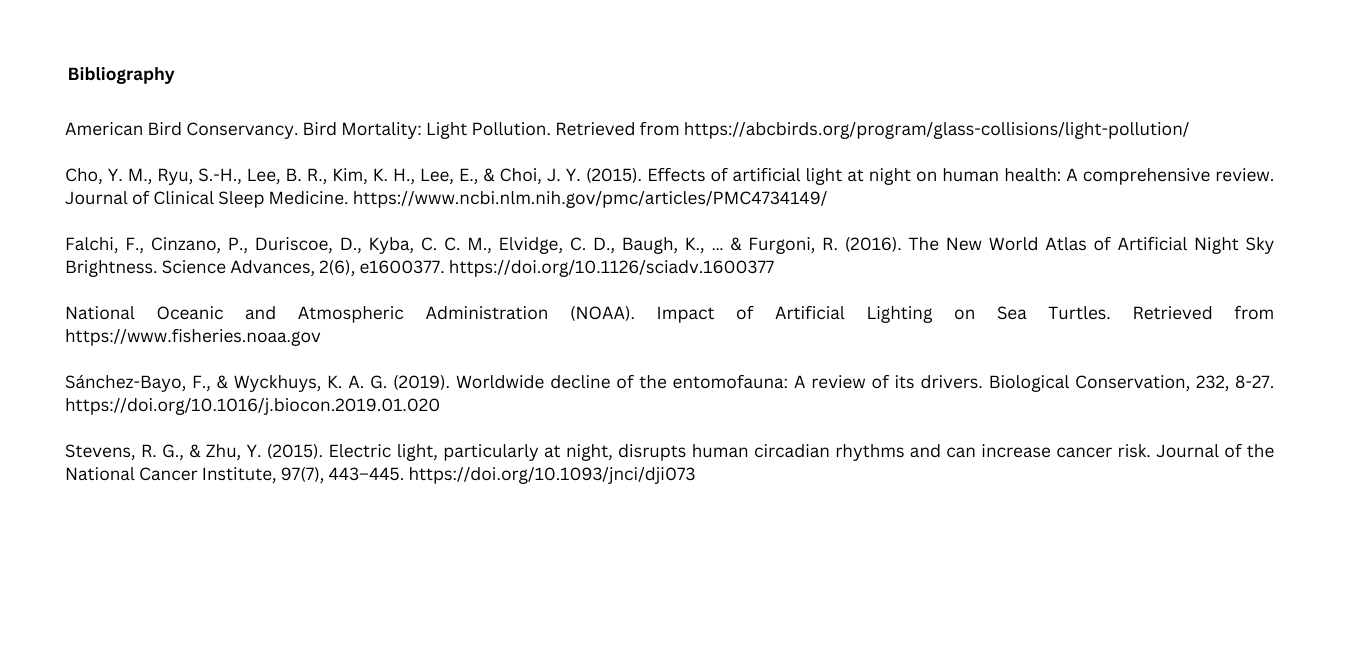Reconnecting with nature
Going Dark
Going Dark: Reimagining artificial lighting in public for a return to natural rhythms
Going Dark is a series of art installations that raises awareness of light pollution and how it can be addressed through collective civic action. The project uses interactive new media formats to immerse participants in a virtual experience of urban and natural spaces at night. By blending art, technology, and environmental advocacy, the project fosters environmental responsibility, empowering communities to take action and spark meaningful local change.
Finland
Regional
The project was installed in several places including:
Helsinki, Finland (Helsinki Design Week, 2023)
Malmö, Sweden (Southern Sweden Design Days, 2024)
Prezcław, Poland (Myln 3D Residency, 2024)
Helsinki, Finland (Helsinki Design Week, 2023)
Malmö, Sweden (Southern Sweden Design Days, 2024)
Prezcław, Poland (Myln 3D Residency, 2024)
It addresses urban-rural linkages
It refers to other types of transformations (soft investment)
Yes
2024-05-24
No
No
No
As an individual partnership with other persons/organisation(s)
Going Dark is a system of interactive installations designed to raise awareness about the negative impacts of light pollution in urban centers. The installation features two formats; a 360º immersive audiovisual display and a virtual reality experience. Footage captured from the Helsinki region transitions from urban and rural views of the night sky, highlighting the differences between light polluted areas and a naturally darker sky. Depending where they look and move, participants trigger reactive elements that display information about the harmful effects of light pollution and practical tools for identifying excessive public lighting.
This project was designed to foster public engagement with the issue of urban lighting and encourage civic collaboration. Through the installation, visitors were invited to reflect on the impact of established infrastructure on the environment and how individual and collective actions can drive change. By raising awareness about the importance of preserving rural dark-sky spaces, the project also sparked conversations beyond the installation itself. Media outreach efforts further amplified its reach and impact.
Going Dark has been publicly presented in Finland, Sweden, and Poland, engaging hundreds of participants and visitors. It has increased awareness of light pollution and its environmental impacts and provided practical guidance on how to address it. Additionally, the project is growing a network of Nordic collaborators, laying the groundwork for future partnerships and initiatives.
Going Dark has the potential to transform the public sphere, encouraging sustainable urban design, preserving natural spaces, and empowering communities to work towards sustaining healthier environments for both people and wildlife.
This project was designed to foster public engagement with the issue of urban lighting and encourage civic collaboration. Through the installation, visitors were invited to reflect on the impact of established infrastructure on the environment and how individual and collective actions can drive change. By raising awareness about the importance of preserving rural dark-sky spaces, the project also sparked conversations beyond the installation itself. Media outreach efforts further amplified its reach and impact.
Going Dark has been publicly presented in Finland, Sweden, and Poland, engaging hundreds of participants and visitors. It has increased awareness of light pollution and its environmental impacts and provided practical guidance on how to address it. Additionally, the project is growing a network of Nordic collaborators, laying the groundwork for future partnerships and initiatives.
Going Dark has the potential to transform the public sphere, encouraging sustainable urban design, preserving natural spaces, and empowering communities to work towards sustaining healthier environments for both people and wildlife.
Light Pollution
Interactive Art
Public Intervention
Climate Art
Social Responsibility
Going Dark advocates for energy conservation and reducing urban light pollution to protect surrounding ecosystems and biodiversity. Excessive artificial light disrupts human sleep cycles, affects mental and physical health, and endangers wildlife by altering natural behaviours like migration, reproduction, and feeding patterns. Addressing this issue promotes healthier environments for both humans and animals while conserving energy. By illuminating the negative impacts of light pollution, participants are able to reconnect with the importance of preserving the environment and human health in the long term. Going Dark offers an experiential perspective on human impact through the use of innovative interactive technology.
Public discourse around this environmental issue is largely absent, despite its significant impact. By engaging with the topic, individuals can reflect on their own sphere of influence and contribute to much-needed change. While costly interventions are inevitable when reworking lighting in the built environment, greater awareness and collaboration can help drive more thoughtful, sustainable solutions. Individual adjustments can be made by using warm-colored lights, dimmers, motion sensors, timers and avoiding blue light in the evening. The larger vision of the project is to empower individuals to reclaim agency over public space, challenging the idea that urban environments are unchangeable. As light pollution becomes more prevalent and studied, Going Dark provides a timely platform to engage the public and inspire meaningful action.
The high level of curiosity sparked in participants is a strong indicator of the project’s success. Many participants expressed surprise at the negative impacts of light pollution and their lack of awareness about its significance as a modern environmental issue. The feedback strongly suggests that the aim of the project is being effectively communicated to participants.
Public discourse around this environmental issue is largely absent, despite its significant impact. By engaging with the topic, individuals can reflect on their own sphere of influence and contribute to much-needed change. While costly interventions are inevitable when reworking lighting in the built environment, greater awareness and collaboration can help drive more thoughtful, sustainable solutions. Individual adjustments can be made by using warm-colored lights, dimmers, motion sensors, timers and avoiding blue light in the evening. The larger vision of the project is to empower individuals to reclaim agency over public space, challenging the idea that urban environments are unchangeable. As light pollution becomes more prevalent and studied, Going Dark provides a timely platform to engage the public and inspire meaningful action.
The high level of curiosity sparked in participants is a strong indicator of the project’s success. Many participants expressed surprise at the negative impacts of light pollution and their lack of awareness about its significance as a modern environmental issue. The feedback strongly suggests that the aim of the project is being effectively communicated to participants.
The aesthetic quality of Going Dark is characterized by its quiet, meditative atmosphere and evolving nightscapes that transition between urban and natural views of the sky. The visuals not only connect participants to the natural world but also offer a rare moment of calm amidst urban life, emphasizing the importance of maintaining natural spaces. The project offers the cultural benefit of raising awareness of light pollution in urban areas. Through innovative design, it transforms obscure information into a tangible, sensory experience, pushing the boundaries of how the public can engage more intentionally. Going Dark serves as a template for fostering local climate activism and deeper community engagement by providing an experience that is accessible, informative and empowering.
Participants noted that they enjoyed the discovery aspect of the installation and found themselves considering light pollution as a significant issue for the first time. This balance of interactive play and peaceful observation makes the installation a meaningful experience on both emotional and intellectual levels.
By harnessing immersion and interactivity, the project empowers participants to reconnect with their social responsibility and take small but tangible steps toward improving their shared environment. For example the installation includes considering the “Five Principles for Responsible Outdoor Lighting” - a guide provided by DarkSky Association that advocates for people to identify what lighting pollution looks like, how to minimize it for private spaces and has a self-certification process for homeowners. Going Dark re-centers the importance of engaging with environmental issues at the local level. It encourages individual action, which collectively strengthens community ties and inspires broader long-term change.
Participants noted that they enjoyed the discovery aspect of the installation and found themselves considering light pollution as a significant issue for the first time. This balance of interactive play and peaceful observation makes the installation a meaningful experience on both emotional and intellectual levels.
By harnessing immersion and interactivity, the project empowers participants to reconnect with their social responsibility and take small but tangible steps toward improving their shared environment. For example the installation includes considering the “Five Principles for Responsible Outdoor Lighting” - a guide provided by DarkSky Association that advocates for people to identify what lighting pollution looks like, how to minimize it for private spaces and has a self-certification process for homeowners. Going Dark re-centers the importance of engaging with environmental issues at the local level. It encourages individual action, which collectively strengthens community ties and inspires broader long-term change.
Going Dark was designed to be an inclusive experience, fostering broad participation and social engagement. The choice of locations was intentional, ensuring the installation reached diverse participant groups. At Aalto University, it engaged students in an academic setting, encouraging critical discussions on design and sustainability. In Malmö, it was presented as part of a panel discussion, inviting a wider public audience into the conversation. Its exhibition at Mitt Möllan, a public gallery space, further extended its reach, making it accessible to a broad and varied community. During an interdisciplinary art residency at MŁYN3D, the project was installed at the final exhibition which gave space to collect more conversational feedback and reach a new audience across different disciplines.
The project promotes inclusive governance by encouraging active civic engagement. By empowering participants to recognize and address light pollution in their own surroundings, it demonstrates how small interventions can lead to meaningful change. Since light pollution is primarily a design issue, it can often be mitigated through revised regulations and enforcement rather than costly infrastructure changes. Participants are encouraged to identify instances of artificial light misuse and pass feedback to municipal and private stakeholders, fostering awareness and action.
By generating dialogue and collective action, Going Dark introduces a new model for social inclusion in environmental advocacy. It promotes community-driven solutions, reconnects individuals to public spaces, and cultivates a shared sense of responsibility for preserving the night sky.
The project promotes inclusive governance by encouraging active civic engagement. By empowering participants to recognize and address light pollution in their own surroundings, it demonstrates how small interventions can lead to meaningful change. Since light pollution is primarily a design issue, it can often be mitigated through revised regulations and enforcement rather than costly infrastructure changes. Participants are encouraged to identify instances of artificial light misuse and pass feedback to municipal and private stakeholders, fostering awareness and action.
By generating dialogue and collective action, Going Dark introduces a new model for social inclusion in environmental advocacy. It promotes community-driven solutions, reconnects individuals to public spaces, and cultivates a shared sense of responsibility for preserving the night sky.
Going Dark actively engaged diverse participants across multiple locations, gathering feedback during both prototype and implementation phases to ensure a broad range of perspectives. Participants offered valuable insights into public awareness of light pollution and their willingness to take action. This feedback serves as a benchmark for understanding awareness levels and informs future iterations of the project, which could shape how urban lighting policies might evolve. The installation encouraged participants to assess responsible outdoor lighting through practical exercises, prompting them to observe and evaluate local lighting practices. It provided links to resources for reporting lighting issues and contributing to ordinance enforcement, as well as directing visitors to the Artificial Light at Night Database for further reading. These tools helped translate awareness into tangible, science-backed solutions for reducing light pollution in their own environments.
Participant feedback played a critical role in fostering dialogue between citizens and municipal stakeholders. Many visitors expressed that the experience gave them a new perspective on the hidden impacts of light pollution, including its effects on human health and ecosystems. This engagement highlights the potential for citizens to influence urban planning decisions and promote sustainable lighting practices. By equipping participants with knowledge and actionable steps, Going Dark demonstrates how inclusive, participatory processes can drive regulatory improvements and tangible reductions in light pollution. The project creates a collaborative space where individuals are empowered to take action and contribute to building healthier, more sustainable urban environments.
Participant feedback played a critical role in fostering dialogue between citizens and municipal stakeholders. Many visitors expressed that the experience gave them a new perspective on the hidden impacts of light pollution, including its effects on human health and ecosystems. This engagement highlights the potential for citizens to influence urban planning decisions and promote sustainable lighting practices. By equipping participants with knowledge and actionable steps, Going Dark demonstrates how inclusive, participatory processes can drive regulatory improvements and tangible reductions in light pollution. The project creates a collaborative space where individuals are empowered to take action and contribute to building healthier, more sustainable urban environments.
Stakeholders from academia, local municipalities, and interest associations, participated in both the design and implementation phases of the project. Insights on research and methodology were gathered through consultations with NorDark, an international research initiative spanning six universities focused on balancing human and environmental needs. The project was designed and developed alongside support from Aalto Studios MediaLab at Aalto University. DarkSky International - Sweden Chapter was actively involved in the initial research phase of Going Dark. Their expertise in light pollution and environmental advocacy helped shape the project's approach and ensured that it aligned with current scientific understanding and best practices. Their input was invaluable in identifying key areas of focus and providing insights into local challenges, making them an essential partner in the project's development.
Correspondence with local environmental officers from the City of Helsinki provided insights into how light pollution is currently managed. The City of Helsinki played a critical advisory role, making information available to us from public and private stakeholders to better inform our processes. Cooperation with the city enables feedback from a wide range of participants to reach relevant authorities, emphasizing public interest in holding stakeholders accountable for improvements to urban lighting infrastructure.
Regionally, Going Dark was presented at Helsinki Design Week: Cooler Planet (Helsinki, FI), Southern Sweden Design Days (Malmö, SE), and at MŁY3D Residency (Przecław, PL). These public engagements facilitated a deeper understanding of the issue for the audience and resulted in panel discussions, interviews, and networking opportunities with professionals, researchers, and visitors alike. Altogether these activities established valuable partnerships and demonstrated the project’s strong potential for further regional expansion and development.
Correspondence with local environmental officers from the City of Helsinki provided insights into how light pollution is currently managed. The City of Helsinki played a critical advisory role, making information available to us from public and private stakeholders to better inform our processes. Cooperation with the city enables feedback from a wide range of participants to reach relevant authorities, emphasizing public interest in holding stakeholders accountable for improvements to urban lighting infrastructure.
Regionally, Going Dark was presented at Helsinki Design Week: Cooler Planet (Helsinki, FI), Southern Sweden Design Days (Malmö, SE), and at MŁY3D Residency (Przecław, PL). These public engagements facilitated a deeper understanding of the issue for the audience and resulted in panel discussions, interviews, and networking opportunities with professionals, researchers, and visitors alike. Altogether these activities established valuable partnerships and demonstrated the project’s strong potential for further regional expansion and development.
Going Dark is a trans-disciplinary project that integrates visual arts, environmental sciences, and urban planning to bridge artistic expression with scientific research and policy development. Each discipline contributed unique expertise, enriching the project through a dynamic exchange of knowledge and practices.
The project began with new media artists designing and producing an interactive installation to raise awareness about light pollution. This involved developing interactive elements, capturing and generating 360º video content, sound design, and adaptation into VR. The artists focused on creating an immersive environment that could effectively communicate complex environmental concepts to a broad public audience in an accessible, engaging format. Consultation with researchers provided critical expertise on the ecological and health impacts of light pollution. Meanwhile, urban planning professionals contributed insights into existing municipal lighting policies and how they could be improved through public engagement. As the project evolved, outreach to NorDark researchers and municipal representatives helped establish practical connections between public awareness, scientific data, and policy action. While these partnerships began during the implementation phase, they will be crucial for future expansions of the project, providing deeper research and stronger community impact.
By combining art, science, and policy, Going Dark fosters civic engagement and highlights the public’s role in shaping urban lighting regulations. It demonstrates how experiential art can drive awareness and action, empowering citizens to advocate for healthier, more sustainable urban and rural environments.
The project began with new media artists designing and producing an interactive installation to raise awareness about light pollution. This involved developing interactive elements, capturing and generating 360º video content, sound design, and adaptation into VR. The artists focused on creating an immersive environment that could effectively communicate complex environmental concepts to a broad public audience in an accessible, engaging format. Consultation with researchers provided critical expertise on the ecological and health impacts of light pollution. Meanwhile, urban planning professionals contributed insights into existing municipal lighting policies and how they could be improved through public engagement. As the project evolved, outreach to NorDark researchers and municipal representatives helped establish practical connections between public awareness, scientific data, and policy action. While these partnerships began during the implementation phase, they will be crucial for future expansions of the project, providing deeper research and stronger community impact.
By combining art, science, and policy, Going Dark fosters civic engagement and highlights the public’s role in shaping urban lighting regulations. It demonstrates how experiential art can drive awareness and action, empowering citizens to advocate for healthier, more sustainable urban and rural environments.
Unlike traditional public communication, which often relies on passive, one-way dissemination of facts, Going Dark redefines engagement by using immersive and interactive technologies to foster a deeper, more empathetic connection to the issue of light pollution. Conventional methods can be static and frontal, limiting emotional involvement. In contrast, Going Dark employs storytelling, an impressive 360º audiovisual environment, spatial interactive elements to turn learning into an emotionally-resonant experience, making the issue feel personal and urgent.
This dynamic initiative extends beyond the installation through panel discussions, social media campaigns, and media interviews, amplifying its impact. These efforts ensure the conversation around light pollution continues outside the immersive experience, reaching diverse audiences and encouraging community dialogue. By combining education with a compelling call to action, Going Dark empowers participants to advocate for sustainable urban lighting practices and hold civic authorities accountable. This multifaceted approach transforms passive observation into active participation, setting a new standard for public engagement on environmental issues.
This dynamic initiative extends beyond the installation through panel discussions, social media campaigns, and media interviews, amplifying its impact. These efforts ensure the conversation around light pollution continues outside the immersive experience, reaching diverse audiences and encouraging community dialogue. By combining education with a compelling call to action, Going Dark empowers participants to advocate for sustainable urban lighting practices and hold civic authorities accountable. This multifaceted approach transforms passive observation into active participation, setting a new standard for public engagement on environmental issues.
The development of Going Dark was rooted in artistic and transformative research methods, combining experiential installation design with community-based approaches. This artistic research sought to communicate the issue of light pollution in a way that was both engaging and accessible. In addition to this, the project employed triangulation as a guiding principle, utilizing multiple research methods to ensure a comprehensive understanding of public perceptions and engagement with the topic.
Key research methods included in-depth interviews with scientists and researchers specializing in light pollution, surveys on participant experiences, and a thorough literature review. These methods were applied to gather both qualitative insights and empirical data, ensuring a balanced approach. By combining these approaches, the project was able to establish a baseline understanding of public awareness and identify the gaps in knowledge regarding the addressability of light pollution through civic discourse.
Modular design principles were integrated into the project to ensure its scalability and adaptability in various urban contexts. This approach enables future iterations of Going Dark to engage new communities, fostering broader cultural awareness and encouraging local action. In doing so, the project aims to contribute to tangible reductions in light pollution by empowering participants to become active in discussions and actions that address the issue.
The outputs of the project included media coverage through articles and social media campaigns, as well as the central piece of the installation: a 360º interactive projection and VR experience. These elements not only served as tools for direct engagement but also amplified the conversation around light pollution, bringing it to a wider audience and creating a lasting impact on local, regional and global scales.
Key research methods included in-depth interviews with scientists and researchers specializing in light pollution, surveys on participant experiences, and a thorough literature review. These methods were applied to gather both qualitative insights and empirical data, ensuring a balanced approach. By combining these approaches, the project was able to establish a baseline understanding of public awareness and identify the gaps in knowledge regarding the addressability of light pollution through civic discourse.
Modular design principles were integrated into the project to ensure its scalability and adaptability in various urban contexts. This approach enables future iterations of Going Dark to engage new communities, fostering broader cultural awareness and encouraging local action. In doing so, the project aims to contribute to tangible reductions in light pollution by empowering participants to become active in discussions and actions that address the issue.
The outputs of the project included media coverage through articles and social media campaigns, as well as the central piece of the installation: a 360º interactive projection and VR experience. These elements not only served as tools for direct engagement but also amplified the conversation around light pollution, bringing it to a wider audience and creating a lasting impact on local, regional and global scales.
Going Dark was designed with modularity at its core, enabling adaptation and replication in various urban contexts to address light pollution in site-specific and targeted ways. The project leverages immersive and interactive technology in multiple formats—large-scale 360º projections for public installations and smaller-scale VR experiences—allowing it to be tailored to diverse settings. This flexibility ensures the project can reach different audiences and scales while maintaining its impact.
Replicating the project in other cities involves several key preparatory steps:
i) Site Research and Data Collection – Conducting site visits to assess local conditions, gather environmental data, and capture 360º video content that reflects the specific lighting challenges
ii) Stakeholder Engagement – Early outreach to municipal officials, environmental organizations, and community groups to foster collaborative participation and establish local partnerships. This approach ensures that the project aligns with municipal goals and has a tangible impact on policy and practice.
iii) Content Adaptation – Tailoring the narrative, visuals, and data to the local context, creating an experience that resonates with the community
The project’s transferable framework combines artistic research with public engagement, making it adaptable beyond light pollution to address other urban environmental challenges such as noise or air pollution. By integrating science-based solutions and participatory engagement, Going Dark offers a replicable model for cities aiming to raise awareness of climate issues through innovative, interactive formats. Future iterations can benefit from incorporating local knowledge earlier in the process to ensure sustained outcomes and stronger civic engagement. Ultimately, the project serves as a blueprint for mobilizing local communities to inspire global action on environmental challenges.
Replicating the project in other cities involves several key preparatory steps:
i) Site Research and Data Collection – Conducting site visits to assess local conditions, gather environmental data, and capture 360º video content that reflects the specific lighting challenges
ii) Stakeholder Engagement – Early outreach to municipal officials, environmental organizations, and community groups to foster collaborative participation and establish local partnerships. This approach ensures that the project aligns with municipal goals and has a tangible impact on policy and practice.
iii) Content Adaptation – Tailoring the narrative, visuals, and data to the local context, creating an experience that resonates with the community
The project’s transferable framework combines artistic research with public engagement, making it adaptable beyond light pollution to address other urban environmental challenges such as noise or air pollution. By integrating science-based solutions and participatory engagement, Going Dark offers a replicable model for cities aiming to raise awareness of climate issues through innovative, interactive formats. Future iterations can benefit from incorporating local knowledge earlier in the process to ensure sustained outcomes and stronger civic engagement. Ultimately, the project serves as a blueprint for mobilizing local communities to inspire global action on environmental challenges.
Light pollution is a global challenge with serious local consequences. It disrupts ecosystems and harms human health, reducing biodiversity and contributing to energy waste. Artificial light at night disorients wildlife: 40% of insect species, including pollinators, are in decline, 100 million migratory birds die each year from light-induced disorientation, and sea turtle hatchlings face a 30% lower survival rate due to coastal lighting. For humans, artificial light exposure suppresses melatonin production by up to 85%, increasing risks of sleep disorders, obesity, depression, and even cancer.
Going Dark addresses this global issue with practical, localized solutions. The project raises awareness of the impacts of light pollution while equipping citizens with tools to identify excessive lighting and report areas for improvement. By establishing a feedback loop between the public and municipal authorities, the project fosters tangible changes in urban lighting practices, encouraging sustainable development at the community level.
By focusing on local engagement and collaboration with municipal stakeholders, Going Dark demonstrates how small-scale efforts can contribute to solving a global issue. The model can be adapted to other cities, showing how local action can pave the way for meaningful environmental change on a larger scale in a broader scope of regions.
Going Dark addresses this global issue with practical, localized solutions. The project raises awareness of the impacts of light pollution while equipping citizens with tools to identify excessive lighting and report areas for improvement. By establishing a feedback loop between the public and municipal authorities, the project fosters tangible changes in urban lighting practices, encouraging sustainable development at the community level.
By focusing on local engagement and collaboration with municipal stakeholders, Going Dark demonstrates how small-scale efforts can contribute to solving a global issue. The model can be adapted to other cities, showing how local action can pave the way for meaningful environmental change on a larger scale in a broader scope of regions.
Going Dark successfully used interactive art to raise awareness of light pollution and inspire civic engagement across three European cities. Through 360º projections, VR, and online media, the project reached about 2,500 people digitally and 500 in person.
Increased Awareness and Understanding:
The project deepened understanding of light pollution, particularly in Helsinki, where a survey showed increased awareness of its health and environmental impacts. While many were already aware, the installation forged a deeper local connection. One participant noted, "where there are humans, nature is often compromised." Survey data also indicated high concern (average rating: 4/5), suggesting alignment with existing environmental consciousness.
Inspiring Civic Engagement and Action:
Feedback suggests the installation encouraged action, with respondents expressing interest in urban planning and sustainable policies. Though the interactive elements required some exploration, they engaged participants, prompting reflection on personal impact. One called it "thought-provoking," emphasizing its role in stimulating critical thinking. Notably, many Helsinki participants said they’d be more likely to act on environmental issues when opportunities were available.
Looking Ahead:
By localizing a global issue through immersive storytelling, Going Dark showed art’s power to inspire civic engagement. Its success across cities highlights public interest in this approach. While long-term behavioral impacts need further study, the project offers a strong model for using art to drive environmental action.
Increased Awareness and Understanding:
The project deepened understanding of light pollution, particularly in Helsinki, where a survey showed increased awareness of its health and environmental impacts. While many were already aware, the installation forged a deeper local connection. One participant noted, "where there are humans, nature is often compromised." Survey data also indicated high concern (average rating: 4/5), suggesting alignment with existing environmental consciousness.
Inspiring Civic Engagement and Action:
Feedback suggests the installation encouraged action, with respondents expressing interest in urban planning and sustainable policies. Though the interactive elements required some exploration, they engaged participants, prompting reflection on personal impact. One called it "thought-provoking," emphasizing its role in stimulating critical thinking. Notably, many Helsinki participants said they’d be more likely to act on environmental issues when opportunities were available.
Looking Ahead:
By localizing a global issue through immersive storytelling, Going Dark showed art’s power to inspire civic engagement. Its success across cities highlights public interest in this approach. While long-term behavioral impacts need further study, the project offers a strong model for using art to drive environmental action.

